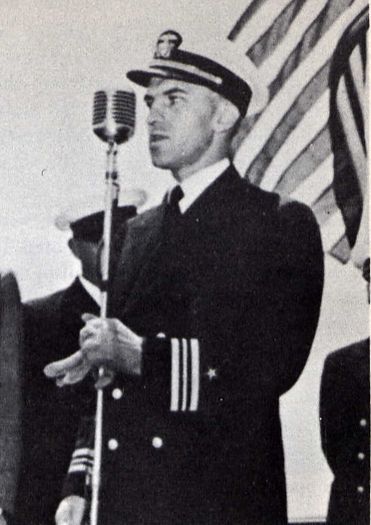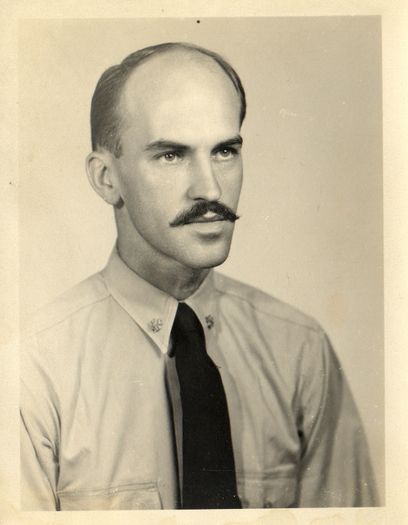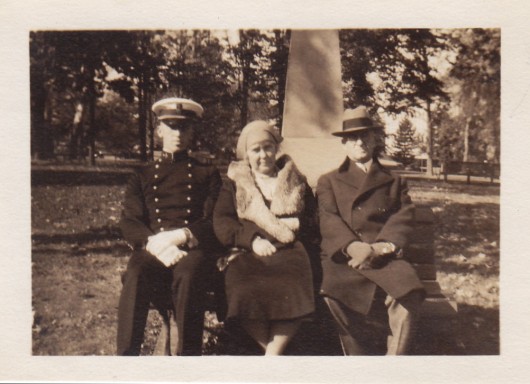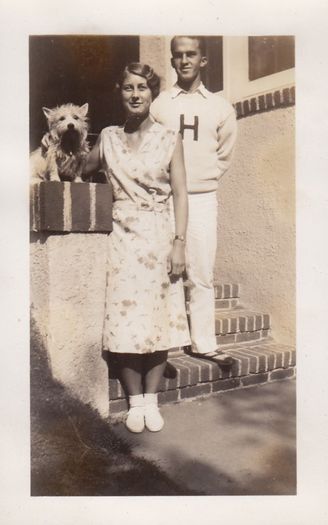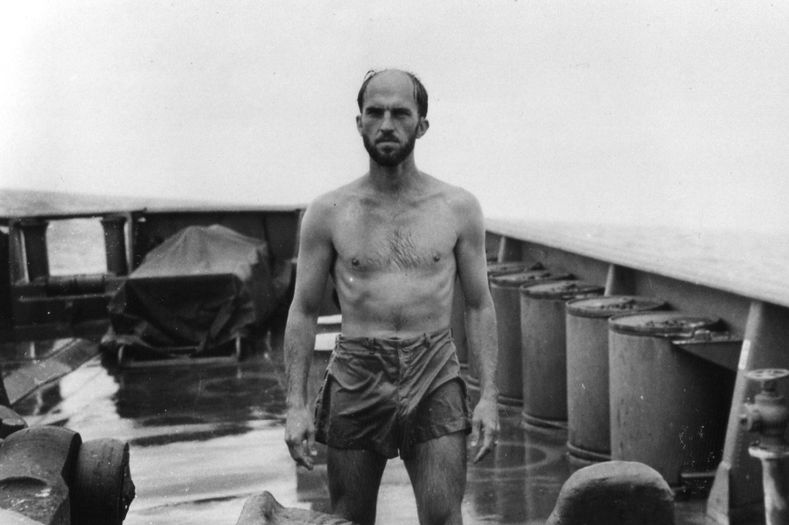PAUL W. BURTON, LCDR, USN
Paul Burton '33
Lucky Bag
From the 1933 Lucky Bag:
PAUL WILLITS BURTON
Ardmore, Pennsylvania
"Paul" "Ahab" "Skippy"
He is just another Marine Junior who came to our haven of rest to spend four quiet years. However, the rest never came. There was always either cross country or track gear drying on the radiator giving the room an athletic atmosphere. Academically—"doggone I wish they would say what they mean in these textbooks" or "if they are going to draw sketches why don't they put in the dotted lines"; but, nevertheless, he always marched to class in the low numbered sections. In between times, it was hard work keeping up with him. There were too many people out in town to take care of himself, so all of his buddies got let in on his "gravy trains," while he went on making new friendships.
We don't yet know all of the places where he spent his childhood days (the Marines seem to go everywhere); but he is on his way back to them now. If the Navy won't take him where he wants to go, there is always the Camel Corps.
Of course there are a few peculiarities. "We may as well go to the movies tonight. We have to pay for them anyway. I wonder who is dragging my Dream Girl tonight?"
Cross Country 4, 3, 2; Track 4, 3, 2; N Club; 2 P. O.
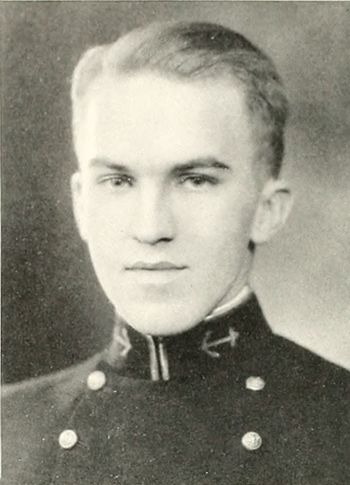
PAUL WILLITS BURTON
Ardmore, Pennsylvania
"Paul" "Ahab" "Skippy"
He is just another Marine Junior who came to our haven of rest to spend four quiet years. However, the rest never came. There was always either cross country or track gear drying on the radiator giving the room an athletic atmosphere. Academically—"doggone I wish they would say what they mean in these textbooks" or "if they are going to draw sketches why don't they put in the dotted lines"; but, nevertheless, he always marched to class in the low numbered sections. In between times, it was hard work keeping up with him. There were too many people out in town to take care of himself, so all of his buddies got let in on his "gravy trains," while he went on making new friendships.
We don't yet know all of the places where he spent his childhood days (the Marines seem to go everywhere); but he is on his way back to them now. If the Navy won't take him where he wants to go, there is always the Camel Corps.
Of course there are a few peculiarities. "We may as well go to the movies tonight. We have to pay for them anyway. I wonder who is dragging my Dream Girl tonight?"
Cross Country 4, 3, 2; Track 4, 3, 2; N Club; 2 P. O.
Loss
Paul was lost on February 13, 1944 when he drowned while attempting to salvage his command, USS Macaw (ASR 11) from a reef near Midway Island.
A harrowing account of Paul's loss, written by Macaw's executive officer from Internet Archive of USS Macaw Memorial Site:
The following is the report Lt. Bud Loughman submitted on the sinking in his capacity as acting commanding officer.
NARRATIVE OF U.S.S. MACAW
16 FEBRUARY 1944About 1430, Captain J. A. CONNOLLY, U.S. Navy, CTG 17.5, Lieutenant Commander David ELLIS, U.S. Naval Reserve and Lieutenant (junior grade) A. W. McDERMID, U.S. Navy, came on board. About then a visual message from CTG 17.5 arrived ordering us to prepare for getting underway preparatory to attempting aid to U.S.S. FLIER aground at entrance channel. Made preparations for getting underway. About 1445, Underway, proceeding out of channel; same time making preparations to take FLIER in tow. Captain CONNOLLY, Commanding Officer, P. W. BURTON, Lieutenant Commander, U.S. Navy, the Executive Officer and the Navigating Officer on bridge. Proceeded out channel, came left and dropped starboard anchor about 1505 so as to be about 50 yards east of No. 2 buoy and 200 yards from FLIER. Veered to 45 fathoms of chain to water’s edge. Ship headed in westerly direction. During this period I was checking progress of preparation, keeping the Commanding Officer informed. We were attempting to place our stern in position by means of propulsion to pass messenger to FLIER, using anchor as pivot. During this time unsuccessful attempts were made to pass messenger to FLIER by motor launch. Ship’s stern was swinging southward, causing motor launch to lose steerageway. Motor launch slipped line, we started hauling in line. The YT 188 came across ship’s stern in order to receive messenger. Heavy swells prevented any contact. About 1535, cleared anchor, underway proceeding to new anchorage. At or about 1545, dropped starboard anchor about 75 yards Northwest of No. 2 buoy. Tried to hold at 30 fathoms of chain but was unable to do so. The strain was so great, chain overrode the wildcat to 75 fathoms. The swells were high enough to cause ship to roll about 35 degrees. Messenger was not ready because of difficulty in retrieving. Men had great difficulty remaining on their feet. Commanding Officer decided to return to lagoon to properly prepare messengers to float to FLIER on the way back out. About 1550, started heaving in on starboard anchor. About 1600, starboard anchor parted in two places, at jew’s harp and at second shot of chain. Remainder of chain was then heaved in. About 1605 port anchor made ready for letting go. The ship had gotten underway when chain parted, all engines on propulsion at I believe 15 knots and was standing in. At about 1609, steering 356 degrees P.G.C. ship was yawing badly due to heavy ground swell and quartering seas. Forward range indicating ship was on right side of channel and buoys #8 and 10 indicated ship in channel.
At approximately 1610 C/C to 354 degrees true. About 1611 C/C to 358 degrees True, ship to right of range but buoy #8 and 10 indicating ship in channel. About 1612 grounded on submerged reef on eastern side of main channel, caused by heavy quartering swell and strong easterly set. The ship seemed to have been lifted suddenly and set upon the reef. Ship hit three distinct times. Ship was about 460 yards north of buoy #2 to the best of my knowledge. Captain ordered all ahead full, left full rudder. Around 1615, all stop was given and then all back full was given to pilot house control. The Commanding Officer had planned to hoist out a stern anchor. Preparations were begun but had to be shortly abandoned due to loss of power.
Shortly after grounding, the shaft alley started to take water. All pumps were put on the shaft alley drain. Since the incoming water was too great to reduce in the shaft alley, all pumps were placed on engineering spaces which were then flooding. Within thirty minutes, the incoming water increased so rapidly it grounded out the main engines in the Generator Room. Shortly after, the 60 KW was put out of commission. The flooded compartments then were the generator room, motor room and shaft alley.
Ship remained in fixed position until heavy weather on 23 January, 1944 drove it further on the reef causing it to list to port. The U.S.S. FLIER was freed in the meanwhile. Salvage crew from U.S.S. CLAMP (ARS33) arrived on board 24 January, 1944 and stayed, going back to CLAMP occassionally, till 10 February, 1944. Three separate unsuccessful attempts were made by CLAMP with aid from other craft to free MACAW. First attempt, started on 29 January, moved MACAW approximately 35 feet aft. Unsuccessful due to inability to sufficiently dewater ship, particularly shaft alley and due to hauling gear casualties. Second attempt 30 – 31 January – shaft alley still flooded despite attempts to seal all outlets for air – also C-203 AL(after crew’s berthing compartment, salvage stores and engineer’s stores) discovered flooded due to hole punched in main deck when submarine rescue chamber carried overboard around 26 January. Both were contributing factors along with difficulties CLAMP and GAYLORD experienced.
The third attempt was made on 8 February. Hauling wire casualties and unfavorable currents and swells forced securing. On 10 February conditions were excellent. Salvage operations got underway in the afternoon. Pumps on board MACAW functioned well during afternoon but generator room pumps, one 6″ and one 10″ were casualties that night due to fouled impellers. Also one 6″ to motor room froze. Shaft alley definitely blown this time as ship was lively except for generator room. It seemed as though ship was pivoting on coral head beneath No. 3 main engine, and that engine would jump and down as much as 18 inches. CLAMP’s hauling wires fouled around coral heads. One was later freed which kept strain on MACAW.
11 February, 1944: Seas picking up. Around 0900 it was decided to wait for better weather, pumps ordered secured. Around 1000, CLAMP reported towing wires clear and ready to pull. 1030 Removed all except Commanding Officer, Executive Officer and 20 men of the MACAW. 1600 CLAMP pitching at mooring, slipped mooring.
MACAW personnel were relieved at intervals. The food situation was usually good. Auxiliary power was procured from a diesel welding machine generator. Quarters were usually cramped due to various lists the ship had most of the time. Aerologist reports from the beach were most helpful forewarning as to what side of the ship to batten down. The wind velocity and the state of the sea were usually greater than predicted however.
12 February, 1944: Ship’s heading at about 0700, 070° True, a 30° increase over previous day, listing 20° to starboard. A 304 AK (Gyro Room, Stores, seas wetting diesel welding machine generator, cutting off auxiliary power for submersible pump. D.W.M. Generator started during morning keeping water down in A 203 AL(CPO Mess and Berthing, etc.). During afternoon seas began breaking over starboard side in force. List increased to 23° starboard due to generator room overflowing main deck, water rising in A-203 AL (CPO Mess and Berthing, etc.). All power gone. Ship suffering heavy beating. HORSMAN later reported the Buda Air Compressor which had hung up on channel bar for skids for No. 1 surf boat, had crashed through bulkhead of recompression room.
Commanding Officer ordered all hands to bridge deck, food and clothing having been brought topside. Spirits of men excellent. Around 1800, it was apparent ship was slowly being forced into deeper water. Water rose from main deck to boat deck in less than an hour. By 1800, water was coming up inside ladder to bridge deck. After bulkhead in chart room pierced and leaking but was shored up with brass rail from Navigator’s desk and mattresses. Water had now reached coaming leading into pilot house. Commanding Officer ordered chart house abandoned, although he stayed in chart house attempting to make door to pilot house watertight. The spray shield along starboard side of bridge deck, about thirty feet in length carried away. It rose on a strengthner about twenty feet into the air and wavered as if it would fall against the ports of the pilot house. The TBY batteries became wet and started smoking. Communication with the Naval Operating Base ceased in the early part of the evening. You could hear the ship straining, as she slipped into deeper water. The ship’s list would increase to such an extent, it was thought she would go over. The ship’s heading also varied considerably. It averaged about 50° True. Water had by nine o’clock forced all hands to the port side. The port to the left of the foremast was used for an air supply and bailing purposes. Three men would hold it shut when tremendous seas would cover us. After losing our bailing cans, the port was dogged sufficiently to let it act as a valve. Three tenths of one percent of pressure was built up each time a wave covered the port. This was determined from the Aneroid Barometer. Water inside held to chest level for several hours. The port wrench was subsequently lost. We no longer could use the ports; Green water was continually covering even the high ones on the port side. Around two thirty (we at the time thought it was earlier) on 13 February, the air space was less than twelve inches to the overhead. Occasional lurches would fill that space with water. The carbon dioxide content became untenable. The Commanding Officer ordered the dogs of the port door released. The door opened with difficulty and stopped when two inches open. The handles were then pushed back an extra inch and the door was pushed open. The Commanding Officer told us to make for the foremast. He waited for the last man to leave before leaving. Before leaving a wave forced me back into the pilot house. That wave cleared the foul air and permitted several of us to get fresh air in the space formed by the top of the door to the overhead. The Commanding Officer and I went topside together. We were apparently washed overboard by the same swell. I could see several men on the foremast. MANNING, George Washington, S1c saw VAUGHN, Robert Andrew, StM1c V-6, USNR receive aid from KOEPKE, Augie Paul, BM2c, USN and in turn help KOEPKE when he needed assistance. MANNING further saw VAUGHN washed forward from the forward searchlight railing into the forward gun mount with such intensity as to knock the gun, locked upright, down. VAUGHN’s body was recovered on the 17th and pronounced by Submarine Base doctor, died from drowning.
William Roscoe FUNK, CPhM(AA), USNR, went topside with MATHERS, Lawrence Howlett, RT1c, V-6, USNR. MATHERS believes they were both swept over simultaneiously. FUNK was never seen again.
Lewis Andrew KINGSLEY, F1c, V-6, USNR, was seen and heard in the vicinity of the main mast by KNECHT, Erwin Richard, MoMM3c, V-6, USNR. He was calling for help. Before Knecht could reach him he was swept out seaward. He was later seen by WILLIAMSON, Richard Blaine, F1c, USNR well free of the ship and apparently in good condition. He was never seen after that. It is believed he was carried under by one of a series of great swells.
Donald Ashley WHITMARSH, MoMM1c, V-6, USNR was in the company of Richard Blaine WILLIAMSON, F1c, V-6, USNR. He was doing fine according to Williamson until a series of great swells separated them. WILLIAMSON nearly was drowned he reports. WHITMARSH was then seen by MANNING trying to make the ship. MANNING threw him a halyard, but a large swell carried him toward shore. He was never seen again.
Paul Willits BURTON, Lt. Comdr., USN, Commanding Officer (jacket No. 72367) was swept overboard with me. We were then separated. About twenty minutes later I called to a group and he heard me. He asked me how I was. He had mentioned to one of the group that the strap of his life belt was broken and he was seen swimming out to sea with the belt under his arm. The belts, although satisfactory when well inflated, had very poor buckles. Most of us had our belts slip off us while in the pilot house a half a dozen times.
KOEPKE, Augie Paul, BM2c, USN had his belt torn off on a 20 millimeter gun mount. HORSMAN, Lewill Edward, SF2c, USNR lost his when he was carried under.
Of the Commanding Officer, Executive Officer and Twenty men aboard at the time of abandoning, the following were saved to date:
SCOTT, C.A., BM2c
KNECHT, E.R., MoMM3cBy Crash Boat from the Naval Operating Base under Lieut. HARDY.
VERKENNES, J.T., S1c
MANNING, G.W., S1c
WADE, E.J., S1c.“PARS” – Crash Boat from Naval Operating Base.
Gerald F. LOUGHMAN, Lieutenant, USNR.
LESTER, N.E., SF2c
KUMLER, C.H., EM2c
BROWN, T.E., CBM(PA)
KOEPKE, A.P., BM2c
WAINSCOTT, C., S1c
EHLERS, H.H., QM2c
MATHERS, L.H.,RT1cThe following men swam ashore to Eastern Island.
WILLIAMSON, R.B., F1c
BOLKE, A.F., GM3c
HORSMAN, L.E., SF2c
LIBERA, S., RM2cTwo 33 foot rearming boats from the Naval Operating Base while assisting in rescuing MACAW personnel overturned with the following known dead or missing:
LELMBECKER, [initials illegible], S1c – Missing.
SAMED, E.D., S1c – Missing.
DAUGHERTY, H.E., S2c – Known dead.This narrative is made from reports from memory by officers and men of the U.S.S. MACAW, from notes received from log of U.S.S. CLAMP, from copies of TBY traffic between the U.S.S. MACAW and CTC 17.5, from reports of officers connected with the salvaging of the U.S. MACAW and lastly from my own memory.
G. F. LOUGHMAN
Acting Commanding Officer,
Senior Surviving Officer.
Other Information
From the 1953 edition of the book "Double Three Roundup," published by the class of 1933:
Paul's first duty after graduation was the SARATOGA in which he served for two and a half years. Early in 1936 he was detached and ordered to Submarine School. Prior to reporting to Submarine School he married Elizabeth Watson of Asbury Park, New Jersey.
Having started on his path as a Submariner, his first assignment was the S-44 on which he remained for three years. The next two years he spent on the R-2. In February of 1941 he was ordered to the Deep Sea Diving School, Navy Yard, Washington, D.C. and became one of the class' deep sea diving experts. From Washington he was ordered to New London where he was assigned duty as instructor of the Submarine Escape Training Tank. Paul painted the first mermaids at the 100 foot depth to encourage the more timid to make the 100 foot escapes.
In July 1942, Paul went to sea again, this time as Executive Officer of the TARPON. After a year on the TARPON he went to the MACAW which was fitting out, in Oakland, California. When the MACAW, a brand new submarine rescue vessel, went into commission in July 1943, Paul was the proud commanding officer. On 13 February 1944 disaster overtook Paul and the MACAW. The MACAW was out during a storm to assist a submarine which had gone aground at the entrance to the channel of Midway Island as a result of the vicious currents. While the MACAW managed to get some line to the submarine which later was helpful in freeing her, the MACAW was swept on the reef also. Before she was freed another storm arose and on the night of February 12-13, the MACAW slid off into the deep water and sank. The survivors spent the last hours in the pilot house, where for some time the water was at chest level. The water continued to rise until there was less than 12 inches between the surface of the water and the overhead. The air got so bad that all hands had to go topside. There the heavy seas soon swept them over the side. Paul was the last to leave the pilot house and was seen by several of the men in the water afterwards. The strap of Paul's life belt broke and he would not stay with the group because they were attempting to assist him in trying to give him one of their belts. He felt they had enough to save themselves. He was last seen swimming with his life belt under his arm in attempt to reach a buoy. His body was never found. During the time all hands were in the pilot house. Paul tried to keep up the men's morale by joking and telling funny stories. His actions to the end were that of a true leader and his men had nothing but praise for him.
In 1950 his wife bought a house, in Haddonfield, New Jersey, and Betty reports that life there is as peaceful as any household containing Barbara (1941), Paul, Jr. (1943), and two dogs can be.
From USS Macaw.org, formerly at http://www.ussmacaw.org:
Paul Willits Burton was born September 29, 1911 — by some accounts in Berkeley, California, by others in neighboring Oakland — the younger of two children, both sons, of Norman Gilbert Burton, a career Marine officer, and his wife, n. Virginia White Willits, the daughter of a rear admiral. Both the Burton and Willits families were from Philadelphia.
Paul traveled extensively with his family as a child, following his father to postings in the Philippines and China. The Burtons were in Manila in 1914, Kobe, Japan, in 1915 and Peking (i.e., Beijing) in 1916. Paul attended schools in Berkeley and Philadelphia, the Peking American School in Peking, University High School in Oakland and the Haverford School outside Philadelphia. In 1929 he enrolled at the US Naval Academy in Annapolis, Maryland, where he ran track and cross-country. He graduated in 1933.
Commissioned an ensign that June, he served about two and a half years aboard the USS Saratoga, one of the nation’s first aircraft carriers. In December 1934 he requested submarine duty. In 1935 he married Elizabeth Porter Watson of Asbury Park, New Jersey. In 1936 he attended submarine school at New London, Connecticut, completed a Naval War College correspondence class in strategy and tactics, reported to submarine S-44, based in the Panama Canal Zone, and received a commission as a lieutenant junior grade. By July 1939 he had completed another Naval War College correspondence course, this one in international law, been deemed qualified for command of submarines by the Bureau of Navigation and reassigned to submarine R-2, based back in New London.
In February 1941 he was assigned to the Navy Yard in Washington, DC, for Deep Sea Diving School. That June he returned again to New London as an instructor at the Submarine Escape Training Tank. In July 1942 he was assigned to the submarine USS Tarpon (SS-175). He reported aboard at the Mare Island Naval Shipyard in Vallejo, California, on San Francisco Bay, where the boat was undergoing an overhaul. Burton served two war patrols aboard the Tarpon, that boat’s fifth (October 22 – December 10, 1942) and sixth (January 10 – February 25, 1943), both under the command of Lieut. Cmdr. Thomas Lincoln Wogan, US Naval Academy class of 1930.
In March 1943 Burton was detached from the Tarpon and assigned to command of the USS Macaw (ASR-11), then being fitted out at the Moore Dry Dock Company in Oakland. He presided at the commissioning of the ship on July 12, 1943, and drowned when the ship sank off Midway February 13, 1944. He left behind his widow, Elizabeth, and two children, Barbara, age 2, and Paul Jr., age 1.
His wife was listed as next of kin. A commenter on the biography above identified himself as Paul's eldest grandson.
Paul is remembered at the Courts of the Missing in Hawaii.
Career
From the now-broken link http://www.fleetorganization.com/subcommandersclassyear3.html:
- Duty USS R-2 (SS-79) 1 Jul 1939 - 1 Nov 1940
- Under Instruction Deep Sea Diving School Navy Yard Washington Feb 1941
- Instructor Submarine Escape Training Tank New London Jun 1941 - 1942
- Executive Officer USS Tarpon (SS-175) Jul 1942 - 4 Mar 1943
- Captain USS Macaw (ASR-11) 12 Jul 1943 - 13 Feb 1944
- Lieutenant (j.g.) 1 Jun 1936
- Lieutenant 23 Nov 1940
- Lieutenant Commander 1 Oct 1942
Photographs
"Paul Burton in his Haverford Prep letter sweater and his bride-to-be, Elizabeth Watson of Asbury Park, New Jersey, c. 1929. Burton ran the second leg on the Haverford mile-relay team that won the event at the 1929 Penn Relays in Philadelphia despite the fact that the third runner dropped the baton."
The "Register of Commissioned and Warrant Officers of the United States Navy and Marine Corps" was published annually from 1815 through at least the 1970s; it provided rank, command or station, and occasionally billet until the beginning of World War II when command/station was no longer included. Scanned copies were reviewed and data entered from the mid-1840s through 1922, when more-frequent Navy Directories were available.
The Navy Directory was a publication that provided information on the command, billet, and rank of every active and retired naval officer. Single editions have been found online from January 1915 and March 1918, and then from three to six editions per year from 1923 through 1940; the final edition is from April 1941.
The entries in both series of documents are sometimes cryptic and confusing. They are often inconsistent, even within an edition, with the name of commands; this is especially true for aviation squadrons in the 1920s and early 1930s.
Alumni listed at the same command may or may not have had significant interactions; they could have shared a stateroom or workspace, stood many hours of watch together, or, especially at the larger commands, they might not have known each other at all. The information provides the opportunity to draw connections that are otherwise invisible, though, and gives a fuller view of the professional experiences of these alumni in Memorial Hall.
July 1933
LT Matthias Marple, Jr. '23 (Fighting Plane Squadron (VF) 6B)
2LT Ernest Pollock '28 (Scouting Squadron 14-M)
LTjg William Arthur '29 (Fighting Plane Squadron (VF) 1B)
LTjg Mathias Wyatt '29 (Fighting Plane Squadron (VF) 6B)
LTjg Lloyd Greenamyer '29 (Fighting Plane Squadron (VF) 1B)
ENS Cleon Felton '31 (Aircraft Squadrons)
ENS James Murphy '31 (Aircraft Squadrons)
ENS George Stone '31 (Aircraft Squadrons)
October 1933
LT Matthias Marple, Jr. '23 (Fighting Plane Squadron (VF) 6B)
2LT Ernest Pollock '28 (Scouting Squadron 14-M)
LTjg William Arthur '29 (Fighting Plane Squadron (VF) 1B)
LTjg Mathias Wyatt '29 (Fighting Plane Squadron (VF) 6B)
ENS Cleon Felton '31 (Scouting Plane Squadron (VS) 2B)
ENS James Murphy '31 (Torpedo Plane Squadron (VT) 2B)
ENS George Stone '31 (Aircraft Squadrons)
April 1934
LT Matthias Marple, Jr. '23 (Fighting Plane Squadron (VF) 6B)
2LT Ernest Pollock '28 (Scouting Squadron 14-M)
LTjg Mathias Wyatt '29 (Fighting Plane Squadron (VF) 6B)
LTjg Charles Ostrom '30 (Scouting Plane Squadron (VS) 2B)
ENS James Murphy '31 (Torpedo Plane Squadron (VT) 2B)
ENS George Stone '31 (Aircraft Squadrons)
July 1934
LT Matthias Marple, Jr. '23 (Fighting Plane Squadron (VF) 6B)
LTjg Charles McDonald '24 (Bombing Plane Squadron (VB) 2B)
LTjg Harold Richards '27 (Aircraft Squadrons)
LTjg Loren Morris '27 (Scouting Plane Squadron (VS) 2B)
LTjg Leonard Southerland '27 (Fighting Plane Squadron (VF) 6B)
LTjg Carl Lindgren '28 (Scouting Plane Squadron (VS) 2B)
LTjg Robert Patten '30 (Aircraft Squadrons)
LTjg Charles Ostrom '30 (Scouting Plane Squadron (VS) 2B)
ENS James Murphy '31 (Torpedo Plane Squadron (VT) 2B)
ENS Eugene Lytle, Jr. '31 (Aircraft Squadrons)
ENS James Kelsey, Jr. '31 (Aircraft Squadrons)
October 1934
LT Arnold Isbell '21 (Aircraft Squadrons)
LT Matthias Marple, Jr. '23 (Fighting Plane Squadron (VF) 6B)
LT Charles McDonald '24 (Bombing Plane Squadron (VB) 2B)
LTjg Harold Richards '27 (Aircraft Squadrons)
LTjg Loren Morris '27 (Scouting Plane Squadron (VS) 2B)
LTjg Leonard Southerland '27 (Fighting Plane Squadron (VF) 6B)
LTjg Mathias Wyatt '29 (Fighting Plane Squadron (VF) 6B)
LTjg Bruce Van Voorhis '29 (Bombing Plane Squadron (VB) 2B)
LTjg Robert Patten '30 (Aircraft Squadrons)
LTjg Charles Ostrom '30 (Scouting Plane Squadron (VS) 2B)
LTjg Charles Palmer, Sr. '31 (Bombing Plane Squadron (VB) 2B)
LTjg James Murphy '31 (Torpedo Plane Squadron (VT) 2B)
January 1935
LT Arnold Isbell '21 (Aircraft Squadrons)
LT Matthias Marple, Jr. '23 (Fighting Plane Squadron (VF) 6B)
LT Charles McDonald '24 (Bombing Plane Squadron (VB) 2B)
LTjg Harold Richards '27 (Aircraft Squadrons)
LTjg Loren Morris '27 (Scouting Plane Squadron (VS) 2B)
LTjg Leonard Southerland '27 (Fighting Plane Squadron (VF) 6B)
LTjg Carl Lindgren '28 (Scouting Plane Squadron (VS) 2B)
LTjg Bruce Van Voorhis '29 (Bombing Plane Squadron (VB) 2B)
LTjg Charles Ostrom '30 (Scouting Plane Squadron (VS) 2B)
LTjg Charles Palmer, Sr. '31 (Bombing Plane Squadron (VB) 2B)
LTjg Ford Wallace '31 (Aircraft Squadrons)
LTjg James Murphy '31 (Torpedo Plane Squadron (VT) 2B)
LTjg Edward Blessman '31 (Aircraft Squadrons)
April 1935
LT Arnold Isbell '21 (Aircraft Squadrons)
LT Matthias Marple, Jr. '23 (Fighting Plane Squadron (VF) 6B)
LT Charles McDonald '24 (Bombing Plane Squadron (VB) 2B)
LTjg Harold Richards '27 (Aircraft Squadrons)
LTjg Loren Morris '27 (Scouting Plane Squadron (VS) 2B)
LTjg Leonard Southerland '27 (Fighting Plane Squadron (VF) 6B)
LTjg Bruce Van Voorhis '29 (Bombing Plane Squadron (VB) 2B)
LTjg Charles Ostrom '30 (Scouting Plane Squadron (VS) 2B)
LTjg Charles Palmer, Sr. '31 (Bombing Plane Squadron (VB) 2B)
LTjg Ford Wallace '31 (Fighting Plane Squadron (VF) 6B)
LTjg James Murphy '31 (Torpedo Plane Squadron (VT) 2B)
LTjg Edward Blessman '31 (Scouting Plane Squadron (VS) 2B)
October 1935
LT John Gillon '20 (Scouting Plane Squadron (VS) 2B)
LT Arnold Isbell '21 (Aircraft Squadrons)
LT Charles McDonald '24 (Bombing Plane Squadron (VB) 2B)
LTjg Charles Signer '26 (Fighting Plane Squadron (VF) 6B)
LTjg Harold Richards '27 (Aircraft Squadrons)
LTjg Elmer Cooper '27 (Bombing Plane Squadron (VB) 2B)
LTjg Leonard Southerland '27 (Fighting Plane Squadron (VF) 6B)
LTjg Oliver White '30 (Scouting Plane Squadron (VS) 2B)
LTjg Ford Wallace '31 (Fighting Plane Squadron (VF) 6B)
LTjg James Murphy '31 (Torpedo Plane Squadron (VT) 2B)
LTjg Thomas Ashworth, Jr. '31 (Fighting Plane Squadron (VF) 6B)
LTjg Edward Blessman '31 (Scouting Plane Squadron (VS) 2B)
January 1936
April 1936
July 1936
October 1939
June 1940
November 1940
April 1941

The "category" links below lead to lists of related Honorees; use them to explore further the service and sacrifice of alumni in Memorial Hall.
